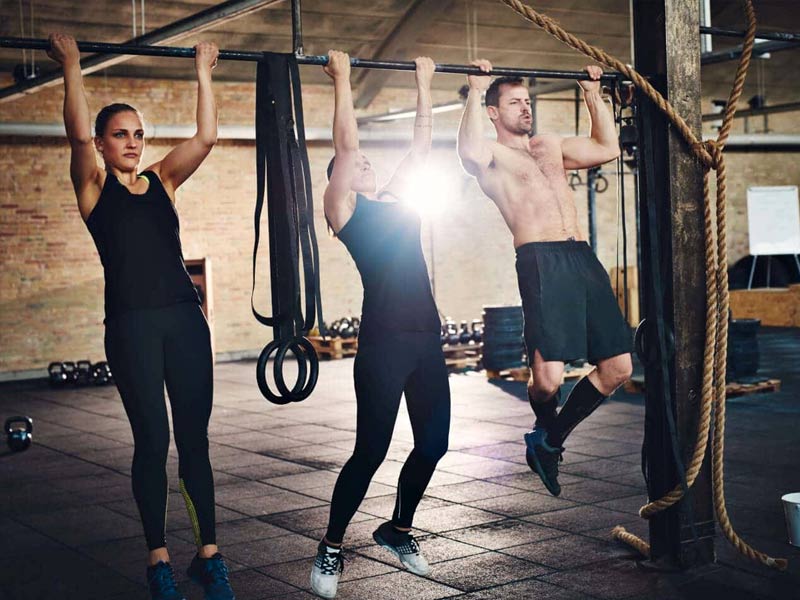What benefits of pull ups will have? An exercise where we merely pull ourselves up!
A Pull Up is a strength training exercise for the upper body. To begin a pull up, grab onto a pull up bar with your palms facing away from you and your body fully extended. Pull yourself up till your chin is above the bar. Pull ups are not the same as chin ups. When performing a chin up, your palms and hands should be facing you.
The pull up is a more advanced workout. It’s a little more challenging than the chin up. However, the pull-up can be tweaked or performed on an assisted machine for beginners, and you will still benefit from these variants.
WHAT MUSCLES DO PULL-UPS WORK?
Before you can comprehend why pull-ups are so vital, you should first gain a feel of the precise muscles that this exercise targets and how the pull-distinctive up’s motion works numerous places at once.
LATISSMUS DORSI
At first glance (or first rep, as the case may be), the pull-up appears to be a movement controlled by the arms and shoulders. On the other hand, pull-ups primarily target the latissimus dorsi, a muscle in your back that isn’t often put to heavy usage in daily life.
Because the lat is such a difficult muscle to target, including smart workouts in your training routine is critical. As a result, the pull-up appeals since it allows you to build an often-forgotten muscle without affecting other sections of the body.

BICEPS
Even though the lats do most of the work, stabilizer muscles in the arms and back also play a role in completing each exercise. Pull-ups, for example, require your biceps. Similarly, a few rapid pull-ups can target the brachialis and brachioradialis, which act in tandem with the bicep.
Simply hanging from the bar will not stimulate these muscles, which will fire up as soon as you resist gravity and raise yourself over the bar. These can be practiced with a standard dumbbell or barbell curl, but pull-ups go above and beyond and are more adaptable. Indeed, with a few modifications (such as limiting the amount of space between your hands), the pull-up can be transformed from a predominantly lat-focused workout to a bicep-heavy activity.
SHOULDERS AND UPPER BACK
Don’t be shocked if your back and shoulders hurt the next day after doing many pull-ups. These muscles aid the lats but may feel even more heat because they are frequently overlooked.
The posterior deltoid, located in the back of the shoulder, is engaged to assist with each pull-up repetition. The lower and middle trapezius muscles also contract, assisting with the pull-up’s concentric (going up) and eccentric (going down) aspects.
Also Read, 6 Best Warm-Up Exercises To Open Up Your Body For Workout
PECTORALS
Not to be overlooked, the pectoral muscles assist with each pull-up. Don’t give up on the bench press just yet; the pec minor’s role in every pull-up is modest. Still, if you want to streamline your workout and need action to help your pecs, the pull-up is the way to go.
Why doing pull ups is necessary?
You should have greater respect for all that pull-ups can achieve now that you understand how they operate and which muscles they target. However, while many individuals have a basic awareness of the muscles involved in a successful pull-up, they struggle to perform this crucial exercise regularly. This reluctance may be due to a lack of understanding of the several ways in which pull-ups can be used to increase strength, stamina, and overall appearance.
These benefits of pull ups are particularly noticeable when performed regularly, as we will explain below:
1. Strengthen the back muscles
The pull up is one of the most efficient exercises for building back strength. Pull ups engage the following back muscles:
- Latissimus dorsi is the largest upper back muscle, running from the mid-back to the armpit and shoulder blade.
- Trapezius: a muscle that runs from your neck to both shoulders.
- The three muscles that run down your thoracic spine are known as the thoracic erector spinal.
- The infraspinatus muscle is placed on the shoulder blade and aids with shoulder extension.
2. Strengthen the arm and shoulder muscles
Pull ups help to develop the arm and shoulder muscles as well. You will work the forearms and shoulders by completing pull ups regularly. Pull ups should be performed regularly if you want to develop your strength in these areas.
If you can’t do the whole pull up, doing them assisted or just getting in position (hanging from the bar) will help you build strength as you work your way up to the full exercise.
3. Increase your grip strength.
Pull ups also aid in the development of grip strength. Lifting weights necessitates good grip strength.
It can also boost performance in various sports such as golf, tennis, rock climbing, and bowling.
A strong grasp is also necessary for everyday duties such as opening jars, walking your dog on a leash, carrying groceries, and shoveling snow.
4. Increase your entire body strength and fitness level.
Strength or resistance training can help you improve your overall fitness. When you do a pull up, you elevate your full body mass with the exercise. This can significantly increase your body’s strength and even your health.
Strength training is beneficial for bone formation and cardiovascular health. For maximum results, strength train with movements like pull ups two to three times each week.
5. Improve your physical health.
Strength or resistance training, such as pull ups, may also benefit your general physical health. According to research, strength training regularly may help reduce visceral fat and help you manage type 2 diabetes.
It can also help lower resting blood pressure and alleviate back pain and discomfort caused by arthritis and fibromyalgia.
Before beginning to strength train, consult with your doctor because it may not be safe for you. The outcomes may also differ from person to person.
6. Improve your mental health.
Resistance or strength training is also beneficial to your mental health. A study review published in 2010 discovered a link between strength training and the following:
- lowering the symptoms of anxiety
- enhancing cognitive function
- lowering tiredness
- lowering depression and increasing self-esteem
While the evidence appears to be good, more research is required to corroborate these findings.
Also Read, 7 Tips To Build A Good Upper Body While Working Out At Home
7. Put your muscles to the test
Pull ups are a difficult strength training exercise. Incorporating them into your routine may help you feel and look stronger if you haven’t done pull ups before. Challenging your muscles with tough movements can also help you increase your overall fitness level.
If you do the same activities over and over, your body will eventually plateau. However, by including new and harder workouts, such as pull ups, you may notice a significant improvement in your strength.

Conclusion:
Pull ups are a difficult exercise. However, they are worth incorporating into your weekly strength training routine. Even if you’re new to pull ups, hanging from the bar or completing an aided pull up can help you begin to build strength.
Try mixing pull ups with other upper body exercises such as pushups, chin ups, tricep extensions, and bicep curls to round out your regimen. This program can be repeated two to three times per week.
Allow a day in between strength training sessions to allow your muscles to heal. Also, before beginning any new strength training plan, consult with your doctor.

























